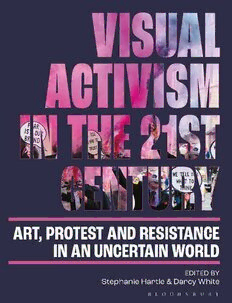
Visual Activism in the 21st Century: Art, Protest and Resistance in an Uncertain World PDF
369 Pages·2022·449.199 MB·English
Most books are stored in the elastic cloud where traffic is expensive. For this reason, we have a limit on daily download.
Preview Visual Activism in the 21st Century: Art, Protest and Resistance in an Uncertain World
Description:
The world is in crisis, bringing activists and protestors onto the streets and into the public eye. More than ever, activism relies on spectacle and visibility in order to be noticed in the era of globalized capitalism and networked media. At the same time, a growing number of artists employ creative strategies to critique the establishment, act in resistance, and demand change. Visual activism of this kind is not new, but it is rapidly evolving.This anthology presents 22 case-studies of visual activism from across the globe, providing an up-to-date picture of the impact of contemporary visual and art activism, and combining a scholarly interrogation of visual activism with an examination of how it works in practice. The case studies address a wide range of issues including human rights abuses; state violence; gender and sexuality; racism; migration; and climate breakdown. They examine a range of approaches from playful carnivalesque parades to extreme practices such as ‘gluing-on’ and ‘lip-sewing’, and are drawn from a wide range of international contexts – from Europe and the US to Israel, Palestine, Iran, India, Pakistan, Tunisia, and China. This diverse scope enables readers to consider examples comparatively – noticing emerging trends and key differences to reveal how geopolitical and cultural factors play an important role in shaping activist practices.This rich and timely collection provides a fresh perspective on the possibilities, limitations and politics of visual activism, as activists, artists, and curators respond to the changing world around them in this most uncertain of times.The world is in crisis, bringing protestors and activists onto the streets and into public attention. Whether small-scale or large, spontaneous or planned, in the era of globalised capitalism and networked media, activism relies on visibility. At the same time artists employ creative strategies to critique the establishment, demand change, act in resistance, and challenge respectability – sometimes known as ‘Artivism’, socially committed art of this kind is not new, but is evolving. Tracing the role of the visual in contemporary activism – from the safer spaces of the art gallery, the networked image, and carnivalesque parades, to more extreme and increasingly desperate practices – the point is always to bring injustice and danger into plain sight and to challenge it.This collection presents sixteen case-studies, each centred on a specific example of visual activism from across the globe, addressing a wide range of issues including: state violence, human rights abuses, inequalities of class, gender and sexuality, racism, sovereignty, migration, mass extinction and climate breakdown. In this rich and timely anthology, scholars explore the surprising variety of current and emerging practices of visual activism, as activists, artists, and curators flex to the changing world around them in this most uncertain of times.
See more
The list of books you might like
Most books are stored in the elastic cloud where traffic is expensive. For this reason, we have a limit on daily download.
